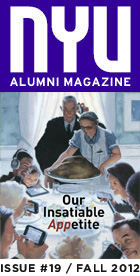nonfiction
Back in the Band
The accordion refuses to be squeezed off stage
by Eileen Reynolds / GSAS ’11
Mention the accordion and many Americans will recall images of TV impresario Lawrence Welk playing the instrument in a leisure suit, or Gary Larson’s Far Side cartoon with the cruel caption: “Welcome to Hell. Here’s your accordion.” But the much-maligned squeezebox wasn’t always so uncool—and, after decades of exile from American pop culture, it just may be making a comeback.
 In Squeeze This! A Cultural History of the Accordion in America (University of Illinois Press),
ethnomusicologist Marion Jacobson (GSAS ’99, ’04) singles out 1908, the year of the
first piano-accordion performance in the United States, as the start of a craze that would last
for much of the 20th century. Brought to this country on a wave of Italian immigration, the
instrument found a home on the vaudeville stage, where it was featured in everything from
ethnic comedy sketches to performances of classical works. At the height of its popularity
in the 1940s and ’50s, middle-class parents signed up their children for lessons,
radio stations hired staff accordionists to play pop songs on the air, and girls in bobby
socks swooned at the feet of Dick Contino, a handsome virtuoso of
Italian-American descent. When slim-trousered heartthrobs ushered in
the guitar-driven rock ’n’ roll era, Jacobson
argues, the accordion didn’t die—it simply went off into a long hibernation.
In Squeeze This! A Cultural History of the Accordion in America (University of Illinois Press),
ethnomusicologist Marion Jacobson (GSAS ’99, ’04) singles out 1908, the year of the
first piano-accordion performance in the United States, as the start of a craze that would last
for much of the 20th century. Brought to this country on a wave of Italian immigration, the
instrument found a home on the vaudeville stage, where it was featured in everything from
ethnic comedy sketches to performances of classical works. At the height of its popularity
in the 1940s and ’50s, middle-class parents signed up their children for lessons,
radio stations hired staff accordionists to play pop songs on the air, and girls in bobby
socks swooned at the feet of Dick Contino, a handsome virtuoso of
Italian-American descent. When slim-trousered heartthrobs ushered in
the guitar-driven rock ’n’ roll era, Jacobson
argues, the accordion didn’t die—it simply went off into a long hibernation.
NYU Alumni Magazine recently caught up with Jacobson to talk about the accordion’s storied past and its current status as a decidedly ungeeky part of everything from world music ensembles to pinup calendars and indie rock bands.
Accordionist Dick Contino had rock-star potential. He drew deafening screams
from teenage girls when he won the
radio talent contest that launched his career in 1946. What went wrong?
It’s such a tragic American tale. We were on the cusp of bringing out an accordion-playing sex symbol, but there were two major problems. The first problem was Dick’s draft record—his inexplicable dodge from army service [during the Korean War]. But had he stayed on track, I’m not sure that he would have crossed over into rock, because his repertoire—“Flight of the Bumblebee,” “Lady of Spain”—was the kitschiest, schmaltziest music. The critics would have killed him, even if his army record hadn’t.
Maybe there was just no place for the accordion in rock ’n’ roll.
Hey, accordions can rock! I mean, couldn’t you imagine Queen with an accordion? Freddie Mercury’s rock was symphonic and epic in its melodic shapes. And who wouldn’t want to hear an accordion with heavy metal? Or think of the ballads of the Beatles. “Rocky Raccoon” has an accordion, for example. In fact, John Lennon played accordion on a couple of songs.
Punk musicians took a shining to the accordion. Why?
By the 1980s, there was an oversaturation of techno. The synthesizer sound had pretty much played itself out. There was a feeling that the accordion made a visceral sound. It’s produced by reeds—metal tongues vibrating—not by a machine. And that feeling was refreshingly human in a way that techno music was not. Flogging Molly, a boisterous Celtic-rock group, really raised awareness of the accordion and its potential to be punk.
What would you put on
a “not your grandpa’s
accordion” playlist?
I would recommend Planet Squeezebox, an anthology of
accordion music from around the world. It’s everything from Basque trikitixa to blues shuffle. For a quick snapshot of indie bands with accordion, there’s an interesting project called the
Accordion Babes Album & Pin-Up Calendar, put out by a collective of West Coast artists every year since 2009. These women are reclaiming the idea of the accordion as sexy, rescuing it from its 1960s and ’70s nadir.
Okay, I’ve got a hand-me-down accordion and am ready to start my band.
Chances are that the accordion in your uncle’s closet will not be in playable condition if it’s more than 40 or 50 years old. The reeds tend to deteriorate. Accordions are quite weather sensitive. They don’t like humidity or moisture. That’s why you see so many beautiful vintage instruments out on the West Coast, because their weather is much more favorable there. That and vintage clothes—accordions and vintage clothing go hand in hand.
Is the world finally ready for an accordion-playing pop idol?
There’s an accordionist out there named Cory Pesaturo who’s got all these plans to play with big stars like Lady Gaga. And he’s handsome, with that tanned Italian-American look. Who knows?







